Brno: A Moravian marvel
By Tracy A. Burns
A respite from Prague
The capital of Moravia and the second-largest city in the country, Brno offers tourists a respite from overcrowded Prague. Its historical center holds a plethora of sights from a cathedral and churches to a castle and museums plus much more. The Cathedral of Saints Peter and Paul and Špilberk Castle (sometimes referred to as Spielberg) dot the skyline of this often-overlooked major town. Take a peek inside the functionalist Villa Tugendhat with its architectural charm. Gaze in awe at the Old Town Hall with its late Gothic ornamentation. Visit the ossuary below Saint James Church. There are many choices for sightseers in this city.
The Cathedral of Saints Peter and Paul
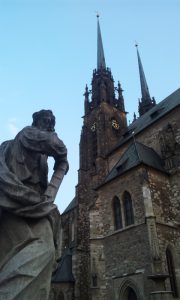 Perhaps the most dazzling sight in Brno, the Cathedral of Saints Peter and Paul sits on Petrov Hill and harkens back to the 12th century. Rebuilt during the 14th and 15th centuries, the then church was completed in 1510. During the Thirty Years’ War, when the Swedes surrounded Brno in 1643, the town’s inhabitants set fire to the buildings below Petrov Hill in an attempt to prevent the Swedes from taking over. Unfortunately, the fire spread to the church. The Swedes did even more damage, and the church found itself in ruins for 100 years. During the 18th century, the Baroque church officially became a cathedral. Then, in the 19th century, it received a Gothic facelift, and a Neo-gothic altar was constructed. The pseudo-Gothic steeples and western portal with a portico date from the early 20th century. In the crypt are remains of the former church’s Romanesque days, the only Romanesque site in Brno.
Perhaps the most dazzling sight in Brno, the Cathedral of Saints Peter and Paul sits on Petrov Hill and harkens back to the 12th century. Rebuilt during the 14th and 15th centuries, the then church was completed in 1510. During the Thirty Years’ War, when the Swedes surrounded Brno in 1643, the town’s inhabitants set fire to the buildings below Petrov Hill in an attempt to prevent the Swedes from taking over. Unfortunately, the fire spread to the church. The Swedes did even more damage, and the church found itself in ruins for 100 years. During the 18th century, the Baroque church officially became a cathedral. Then, in the 19th century, it received a Gothic facelift, and a Neo-gothic altar was constructed. The pseudo-Gothic steeples and western portal with a portico date from the early 20th century. In the crypt are remains of the former church’s Romanesque days, the only Romanesque site in Brno.
The interior of the cathedral
The cathedral is stunning, to say the least. The three stained glass windows, dating from 1891 and located behind the golden neo-Gothic altar, tell the story of Saints Peter and Paul. The Gothic Madonna near the entrance possibly dates from the 13th century. A choral chapel dedicated to the Virgin Mary hails from the 15th century. The elaborate Baroque pulpit was completed in 1775. Take a look at the putti holding a crown and the angel gripping a golden key. Notice that the cathedral’s bells toll at 11 am instead of at noon. A legend says that, during the Thirty Years’ War, the Swedes had promised to halt their attack on the city if they did not conquer Brno by noon, so the town’s inhabitants rang the bells an hour earlier, preventing the Swedes from conquering the city.
Capuchin crypt
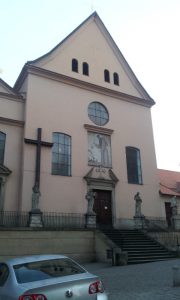 Another Brno highlight – though not for the squeamish – is the early Baroque Capuchin crypt, a burial site of friars, nobles, and benefactors from 1651 to 1784. Of the 205 bodies placed in the crypt, 41 have been preserved. The remains decayed naturally; they were not mummified. General and Count Jan Vilém Zinsendorf is the oldest preserved body in the crypt, dying in 1695. Take note of the arm and leg spasm-like positions of his wife, Isabela Zinsendorf; she was probably buried alive. A group of skeletons lying together in one area exhibits how Capuchins buried their friars. After the funeral, the dead were moved to the crypt, where the bottom of the coffin was pulled out. This way the coffin could be used for multiple funerals. The Capuchins put a few bricks under the corpse’s head. Of the 153 friars buried in this manner, 24 have been preserved.
Another Brno highlight – though not for the squeamish – is the early Baroque Capuchin crypt, a burial site of friars, nobles, and benefactors from 1651 to 1784. Of the 205 bodies placed in the crypt, 41 have been preserved. The remains decayed naturally; they were not mummified. General and Count Jan Vilém Zinsendorf is the oldest preserved body in the crypt, dying in 1695. Take note of the arm and leg spasm-like positions of his wife, Isabela Zinsendorf; she was probably buried alive. A group of skeletons lying together in one area exhibits how Capuchins buried their friars. After the funeral, the dead were moved to the crypt, where the bottom of the coffin was pulled out. This way the coffin could be used for multiple funerals. The Capuchins put a few bricks under the corpse’s head. Of the 153 friars buried in this manner, 24 have been preserved.
Saint James Church with the ossuary
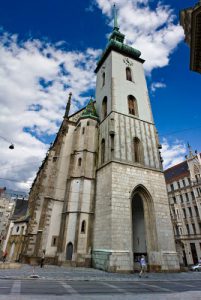 The most beautiful church in Brno is Saint James Church, declared a national monument in 1995 and hailing from the 13th century. Gargoyles greet visitors outside the church that was not damaged during the Thirty Years’ War. Inside, the Gothic vaulting is overwhelming. The interior still has Baroque elements from the Baroque reconstruction during the 18th century, although this gem was transformed back to the Gothic style in the 19th century. Baroque paintings with marble altars adorn the church that has a neo-Gothic main altar with a scene of the crucifixion above the statue of Saint James. Six headstones also decorate the interior as a cemetery used to be on the grounds. The entrancing pulpit goes back to late Gothic days while the tower is 94 meters high. The artwork is eclectic, ranging from Gothic to modern. Do not pass on a visit to the crypt, with 50,000 skeletons in a three-chamber space. It was possible to preserve the remains of many people in the relatively small space of an ossuary rather than in individual graves. Other churches of note in Brno include the charming Gothic Basilica of the Assumption of our Lady and the Church of Saint John with a Loreto Chapel that resembles the Holy House in Loreto, Italy, and includes a replica of the Black Madonna.
The most beautiful church in Brno is Saint James Church, declared a national monument in 1995 and hailing from the 13th century. Gargoyles greet visitors outside the church that was not damaged during the Thirty Years’ War. Inside, the Gothic vaulting is overwhelming. The interior still has Baroque elements from the Baroque reconstruction during the 18th century, although this gem was transformed back to the Gothic style in the 19th century. Baroque paintings with marble altars adorn the church that has a neo-Gothic main altar with a scene of the crucifixion above the statue of Saint James. Six headstones also decorate the interior as a cemetery used to be on the grounds. The entrancing pulpit goes back to late Gothic days while the tower is 94 meters high. The artwork is eclectic, ranging from Gothic to modern. Do not pass on a visit to the crypt, with 50,000 skeletons in a three-chamber space. It was possible to preserve the remains of many people in the relatively small space of an ossuary rather than in individual graves. Other churches of note in Brno include the charming Gothic Basilica of the Assumption of our Lady and the Church of Saint John with a Loreto Chapel that resembles the Holy House in Loreto, Italy, and includes a replica of the Black Madonna.
Špilberk Castle
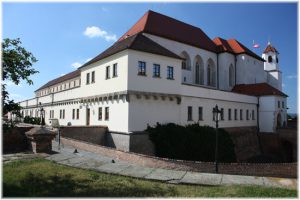 Founded in the 13th century by the Přemyslid dynasty of Czech kings, Špilberk Castle was the seat of the Moravian margraves during the 14th century. After the Uprising of the Estates in 1621, it became a prison, this time for Protestant noblemen who had instigated the revolt against the Catholic Habsburgs. It would serve as a prison, with some interruptions, through 1939. In 1645, during the Thirty Years’ War, the structure withstood Swedish attacks for more than four months. Later, during the 18th century, it became a prison for hardened criminals under the Habsburg regime. Italian patriots were known as Carbonari and also served time here. The most famous of that Carbonari, poet Silvio Pellico, wrote a classic about his experiences there, called My Prisons. During the late 18th century, the incarcerated were chained to planks and beams in the former casemates. Civilians opposing the Habsburg regime were kept here throughout World War I. It even served as a prison for political offenders during 1939 under the Nazi regime. The Czechoslovak Army occupied it until 1959 when it became a museum.
Founded in the 13th century by the Přemyslid dynasty of Czech kings, Špilberk Castle was the seat of the Moravian margraves during the 14th century. After the Uprising of the Estates in 1621, it became a prison, this time for Protestant noblemen who had instigated the revolt against the Catholic Habsburgs. It would serve as a prison, with some interruptions, through 1939. In 1645, during the Thirty Years’ War, the structure withstood Swedish attacks for more than four months. Later, during the 18th century, it became a prison for hardened criminals under the Habsburg regime. Italian patriots were known as Carbonari and also served time here. The most famous of that Carbonari, poet Silvio Pellico, wrote a classic about his experiences there, called My Prisons. During the late 18th century, the incarcerated were chained to planks and beams in the former casemates. Civilians opposing the Habsburg regime were kept here throughout World War I. It even served as a prison for political offenders during 1939 under the Nazi regime. The Czechoslovak Army occupied it until 1959 when it became a museum.
The permanent exhibition and casements
The permanent exhibition covers the history of the castle with displays ranging from ceramics and tiles to Nazi armbands and Jewish stars. The castle grounds also boast a lookout tower, a Baroque pharmacy, and casements that portray prison life there during the late 18th century. Cells of various sizes, a prison kitchen, torture chamber, guard cells, and the Josephian cells that were made of timber and used for the worst crimes during the late 18th century are featured there.
Villa Tugendhat – UNESCO
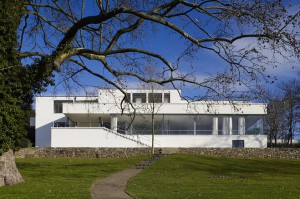 Listed as a World Cultural and National Heritage UNESCO site since 2001, Brno’s Villa Tugendhat is an architectural wonder due to its structure, layout, furnishing, setting, and technical equipment. Its use of rare and exotic materials also makes this functionalist home designed by architect Ludwig Mies van der Rohe unique. This steel load-bearing structure of reinforced concrete is noted for its openness. Its unique furnishings include chairs designed by the architect specifically for the house and an onyx wall. Located in the Brno residential quarter of Černá Pole at 45 Černopolní Street, the villa boasts 80 percent of its authentic furniture. It opened to the public again in March of 2012 after a two-year renovation.
Listed as a World Cultural and National Heritage UNESCO site since 2001, Brno’s Villa Tugendhat is an architectural wonder due to its structure, layout, furnishing, setting, and technical equipment. Its use of rare and exotic materials also makes this functionalist home designed by architect Ludwig Mies van der Rohe unique. This steel load-bearing structure of reinforced concrete is noted for its openness. Its unique furnishings include chairs designed by the architect specifically for the house and an onyx wall. Located in the Brno residential quarter of Černá Pole at 45 Černopolní Street, the villa boasts 80 percent of its authentic furniture. It opened to the public again in March of 2012 after a two-year renovation.
Other architectural sights
Other architectural sights in Brno include the functionalist Exhibition Center, created in 1928. Those are by no means the only functionalist buildings in the town: Kudela’s house, Kroh’s house, Psota’s house, Stein’s house, and the former villa of the late Czech philosopher and dissident Jan Patočka are a few of the avant-garde highlights.
Old Town Hall
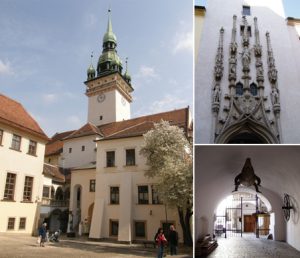 Hailing from the 13th century, the Old Town Hall is the oldest secular building in the city. It features a late Gothic gate with elaborate décor as well as a crocodile (representing a dragon) and a wooden wheel hanging on the gateway. According to legend, a dragon threatened inhabitants until a butcher tricked it with lime bait and slew it. The wooden wheel promotes another legend. In the 17th century, a wheelwright from the southern Moravian town of Lednice bet that he could cut down a tree, transform it into a wheel in less than 12 hours, and roll it all the way to Brno. The wooden wheel symbolizes his success. The courtyard is worth seeing, too. Its Renaissance arcades enthrall visitors. During the summer, historical halls are open to the public. The 63-meter high tower is another attraction, offering splendid views of the city. The Old Town Hall is closed to the public in 2012.
Hailing from the 13th century, the Old Town Hall is the oldest secular building in the city. It features a late Gothic gate with elaborate décor as well as a crocodile (representing a dragon) and a wooden wheel hanging on the gateway. According to legend, a dragon threatened inhabitants until a butcher tricked it with lime bait and slew it. The wooden wheel promotes another legend. In the 17th century, a wheelwright from the southern Moravian town of Lednice bet that he could cut down a tree, transform it into a wheel in less than 12 hours, and roll it all the way to Brno. The wooden wheel symbolizes his success. The courtyard is worth seeing, too. Its Renaissance arcades enthrall visitors. During the summer, historical halls are open to the public. The 63-meter high tower is another attraction, offering splendid views of the city. The Old Town Hall is closed to the public in 2012.
Museums in Brno
The Moravian Gallery manages five buildings, including an art collection that ranges from medieval times to the 19th century at the Governor’s Palace. Peter Paul Rubens’ “Head of Medusa,” the mythical figure who turned people into stone when they looked at her, is the gallery’s pride and joy. Painted from 1617 to 1618, the work features the slivering, slimy snakes in Medusa’s hair and her bloodshot eyes staring into emptiness. Medieval art is the collection’s strength, though. Check out the 14th and 15th century Madonnas. Located in Pražák Palace, the Museum of Modern and Contemporary Art flaunts modernist works and those representing the inter-war avant-garde. The collection features painter Antonín Procházka, and there are also works by Josef Čapek, Emil Filla, Bohumil Kubišta, and other major Czech artists. The Museum of Applied Arts covers the Middle Ages to the 20th century in an enticing collection of furniture, textiles, glass, ceramics, china, and more. The intriguing 1906 house of Slovak architect Dušan Jurkovič, who focused on Secession and folk art, is located in the Žabovřeksy suburb. The house itself boasts a British and Viennese design with folk elements. The interior displays his work created in the Czech lands and Slovakia. Another charming museum is the Mendel Museum in the Augustinian abbey where abbot and scientist Gregor Johann Mendel had actually worked. The five rooms focus on the life and accomplishments of the man considered to be the father of modern genetics.
Freedom Square and Cabbage Market Square
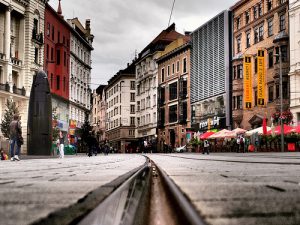 The busiest and oldest square in Brno, Freedom Square hails from the 13th century. In addition to a Baroque Plague Column, the square features the House of Lords of Lipá, a Renaissance gem; the neo-Renaissance Klein’s Palace, and The House of Four Atlantes with dynamic, sculptured male figures. Fruit and flower stands dominate Cabbage Market Square with its 17th-century Parnas Fountain, symbolizing a cave where Hercules ties up the dog Cerberus. Allegorical sculptures have been forged inside the cave. Underneath the square is a labyrinth of corridors and cellars accessible in a tour that lasts 40 minutes and goes six to eight meters underground. The Mintmaster’s Cellar at Dominican Square is another underground experience.
The busiest and oldest square in Brno, Freedom Square hails from the 13th century. In addition to a Baroque Plague Column, the square features the House of Lords of Lipá, a Renaissance gem; the neo-Renaissance Klein’s Palace, and The House of Four Atlantes with dynamic, sculptured male figures. Fruit and flower stands dominate Cabbage Market Square with its 17th-century Parnas Fountain, symbolizing a cave where Hercules ties up the dog Cerberus. Allegorical sculptures have been forged inside the cave. Underneath the square is a labyrinth of corridors and cellars accessible in a tour that lasts 40 minutes and goes six to eight meters underground. The Mintmaster’s Cellar at Dominican Square is another underground experience.
Theatre in Brno
Czech speakers should not miss the enthralling performances of HaDivadlo, Bolek Polívka’s Theatre, or Goose on a String Theatre. The Mahen Theatre, a Neo-Renaissance, Neo-Baroque, and Neo-Classicist building, has a remarkable façade of Tuscan and Corinthian Columns and statuary dominated by Dionysus in a carriage drawn by lions and panthers. Now one of the stages for the National Theatre of Brno, it was one of the first public buildings in the world totally lit by electric lighting. The Janáček Theatre, also part of the National Theatre of Brno, offers operas and ballets in its repertoire for English speakers.
A gateway to castles, caves, and more
Castles, chateaus, and caves are only a short bus ride or train ride away from Brno. Do not miss out on the castle and chateau at Boskovice, Buchlov Castle and Buchlovice Chateau, or the Pernštejn Castle, one of the most enthralling sights in the entire country. Chateaus in Slavkov, Rájec nad Svitavou and Lysice are yet other bewitching destinations. Take advantage of Brno’s proximity to the Moravian Karst and its awe-inspiring caves, such as the astounding Punkva Cave. Brno serves as a gateway to the many splendors of Moravia.



